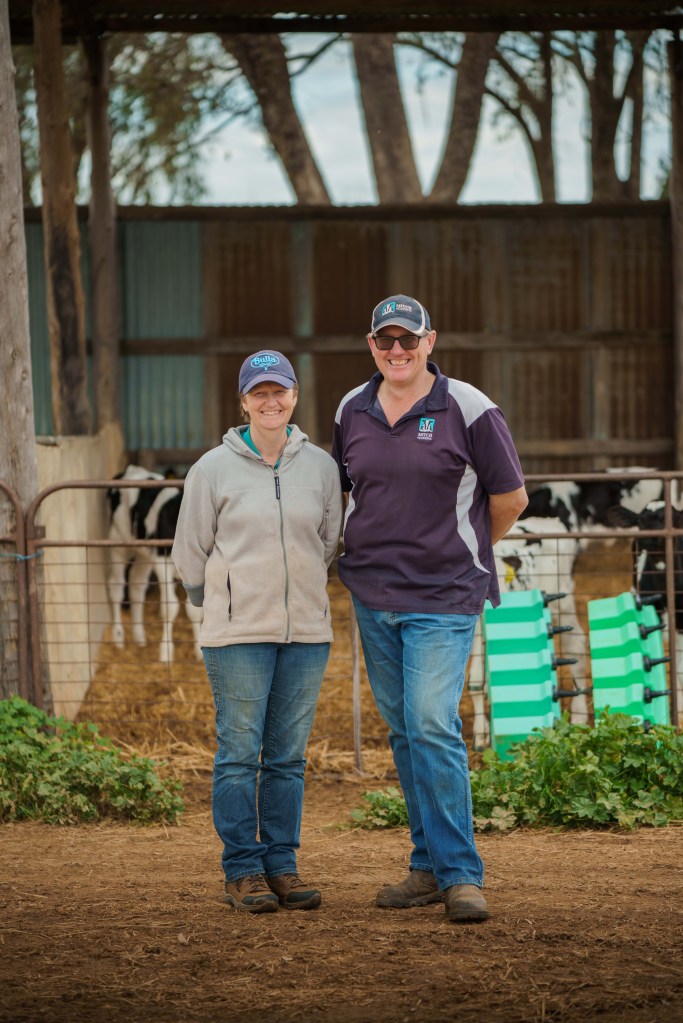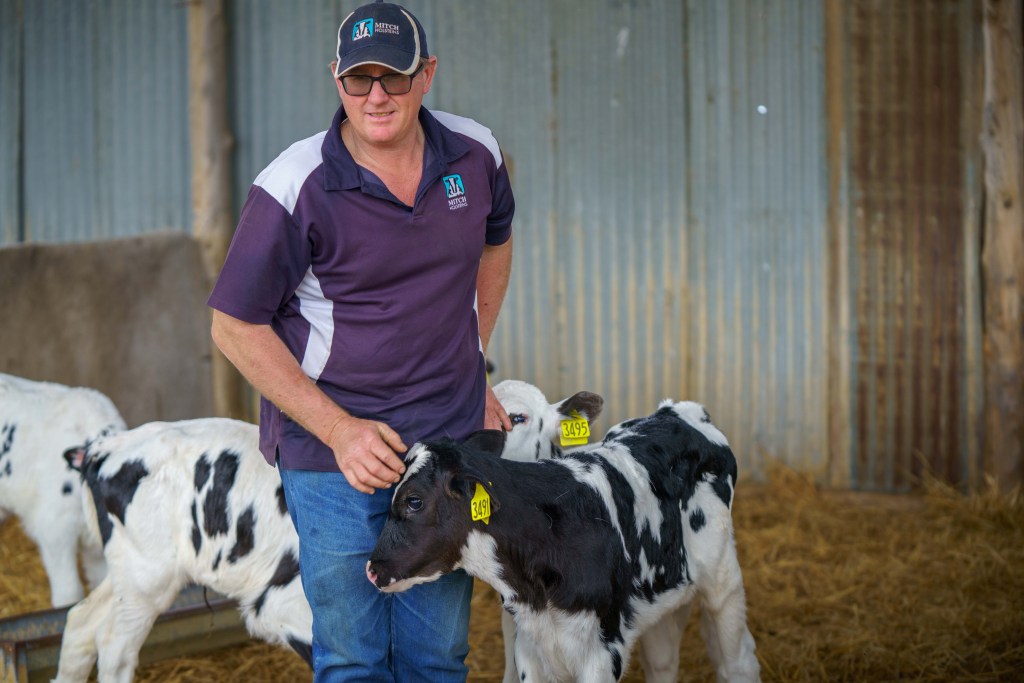Brent Mitchell shares his story
His story:
Mitch Holsteins in Bamawm, Victoria is run by Brent and Kim Mitchell. They milk just short of 300 cows with split calving in autumn and spring and do all their own AI work. They have around 400ha of farm spread between three different locations.

“We place a big emphasis on cows, we love our registered cows. Our focus is looking after our cows. When we look after them, they’ll look after us and give us good production back.”
Brent grew up on a commercial dairy farm. His grandfather started the farm with around 60 cows, and his parents pushed that number to about 120. Farming has always been in his blood, but when he was old enough to start working, the family farm just wasn’t big enough, so he set his sights on other roles in the industry. He spent a while working in herd improvement, AI, the reseller market, and genetic sales before coming back to farming. “I got sick of working with other people’s cows and wanted to work with my own,” he said.
Kim comes from a beef background, and according to Brent, “she said she was never going to marry a dairy farmer but made the mistake of saying yes and now she’s here dairy farming”. After getting married and deciding on dairy farming, the couple began sharemilking and ended up back in Bamawm in 2011. “We then took that step to go a bit harder and build that up with the addition of extra land here and there in the last few years – it’s been a journey,” Brent said. “We work pretty hard and wear out sometimes, but we enjoy what we do,” he added.
They do a good job of juggling the jobs and separate locations with plenty of help from family and workers. “My parents oversee the heifer and fodder farm, we couldn’t do it without their day-to-day help, and we get a lot of support from Kim’s parents as well. Then we’ve got one full-time staff member who milks and feeds cows and another part-time guy that helps with projects and maintenance,” Brent said.
He said he learns a lot from other people in the industry who he considers his mentors as well. “Most of them are involved in the stud industry in one way or another, not just in Holsteins, there are some guys that I rate as pretty good farmers from my time in the herd improvement industry, and I look closely at what they’re doing and ask a lot of questions.”
The genetic plan for his farm:
“The passion for genetics I was born with I think, Mum says right from when I was three or four, she knew I was going to be doing something with cows because I was just mad on cows,” he said.
His parents and grandparents never had any sort of registered animals but once Brent had been out and seen what was going on in the wider industry, it quickly became clear that’s where he’d head. “If I’m going to get out of bed early in the morning and milk cows, I’m going to try and milk good ones,” he commented.
He said they’ve invested a lot of money over the years to buy into great cow families to build a quality herd, but it’s a slow process. “You sort of start off slow and only have a few. You only get a few calves every year and you think it’s going to take forever. But all of a sudden you do start to build those numbers, and it very quickly changes,” he added.
He has a pretty tight calving season, with around 100 of the 130 cows calving within the first month, but he wants to focus on getting more cows in calf. “My theory is when you use sexed semen that 95% of them are going to be heifers, so I try to avoid the long gestation bulls because that’s usually where the issues come with calving ease. We just keep an eye on the gestation length of what we use in Sexcel and that usually gives us good calving ease.” He believes there’s nothing worse than spending a lot of money on rearing a nice cow, just to wreck her getting that first calf out.
“I also believe that if you just choose calving ease, what you’ll end up with is something that’s too narrow and unbalanced at the other end too. So that’s why I look at the gestation length to help with our calving ease.”
Sexcel® and Beef InFocus™:
Ever since Sexcel Sexed Genetics has been in the market, they’ve focused heavily on using that within their herd. “Our two-year-olds get bred to sexed now, all our flush work is getting done with Sexcel so that makes a hell of a difference on the number of heifers we have.” Now they’ve started being a little stricter on which cows they keep in the herd. “Once you’ve got the numbers then you can start putting pressure on your selection and what you keep or bring into the herd, that’s when the improvement really starts to happen.”
With an increased number of heifers, Brent and Kim started looking at what they could do with the cows in their herd that they didn’t want to breed replacements from. They started using beef bulls over some of their herd and have recently changed to using ABS Beef InFocus for consistency.
“Some of those cows just aren’t quite up to scratch of what I want to breed from, so providing a good Beef InFocus angus cross calf has been a good way of adding another revenue stream to the business. They’ve been good calves; we haven’t had much trouble with them. It’s a tool that we can all utilise and another revenue stream that we can look at.”

Challenges:
Like most dairy farmers, Brent and Kim have their fair share of challenges in the industry. Brent said the two biggest for them are cost control and public perception. “At the moment with the record prices we’ve got, it’s good, but you’ve still got to make sure you’re wise when it comes to how you spend your money.”
“Public perception of the dairy industry is also a massive thing. They tend to knock us because they believe the rhetoric that’s out there, which is disappointing because you put a hell of a lot of work into looking after your cows and it’s not nice when people reckon you don’t do it.”
Brent and Kim like to place focus on what extra things they can do to look after their cows, trusting that a happy and healthy cow is what makes you the most money. “I’m a bit hopeless at times, I don’t do everything that’s perfect for the bottom line, but you do what’s right for the cow and try and do things to the best of your ability and to as high a standard as you can,” Brent said.
They both commented on how cows can be easy to work for when they’re full and happy and content, and that when your cows are happy, you can be happy too. “When this farmer is grumpy is when his cows aren’t happy,” Brent added.
His Experience with ABS:
Brent credits his good working relationship with ABS Australia to his personal relationship with Representative Bill Morgan. “He’s been fantastic, and Brian Behnke (St Jacobs Manager) has been out and visited the farm as well,” he said.
Mitch Holsteins had success when their three-year-old cow Mitch Aftershock Irene won Holstein Intermediate Champion at the 2017 International Dairy Week. “He (Brian Behnke) fell in love with the Aftershock Irene cow, so we’ve kept in contact with him,” Brent said.
“They’ve been really good to work with. We’re stuck on the farm, so we don’t get to see anywhere near the number of cattle these guys get to see, it’s great to get a real honest opinion on what they’re seeing around the country and around the world. It’s a worldwide market we’re working in now so it’s good to get that hands-on information – they’re great to work with.”
